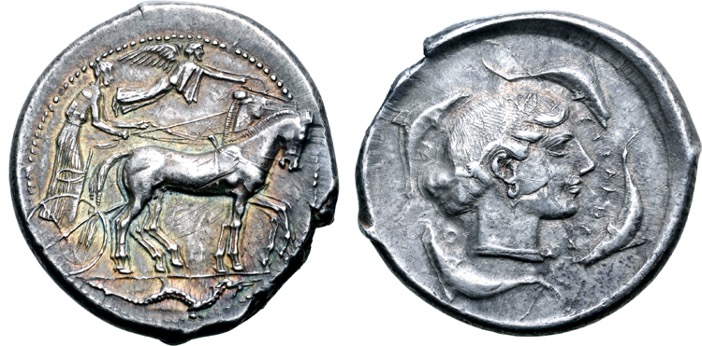440 BCE - 430 BCE | ΣΥΡΑΚΟΣΙΩΝ
Overstriking coin
2589_-_Syracuse_(tetradrachm_biga-Arethuse).jpg
[1]
|
|
Sale(s)Sale(s) ᵖ:
|
Roma Numismatics, XXII, 7 Oct. 2021, 180 ; Jean Elsen & ses Fils S.A., Auction 93, 15 September 2007, 662.
|
|
|
|
Description
| ObverseInscription or printing placed on the obverse.:
|
Charioteer, holding kentron and reins, driving slow quadriga to right, Nike flying above to right, ketos in exergue
|
ReverseInscription or printing placed on the reverse.:
|
ΣΥΡΑΚΟΣΙΩΝ (Greek) Head of Arethusa to right, wearing sphendone. Four dolphins around
|
Mint and issuing power
| MintIdentifies the place of manufacture or issue of a numismatic object.:
|
Syracuse
|
Ancient regionAncient region.
|
Sicily
|
Modern countryModern country: Italy
|
AuthorityIdentifies the issuing power. The authority can be "pretended" when the name or the portrait of X is on the coin but he/she was not the issuing power. It can also be "uncertain" when there is no mention of X on the coin but he/she was the issuing power according to the historical sources:
|
|
Chronology
| FromIdentifies the initial date in a range assigned in a numismatic context. 440 BCE toIdentifies the final date in a range assigned in a numismatic context.. 430 BCE
|
Classical 480-323 BC  periodTime period of the numismatic object. periodTime period of the numismatic object.
|
Physical description
MetalThe physical material (usually metal) from which an object is made.: Silver 
|
WeightWeight of the numismatic object (in grams). in grams: 17.0617.06 g <br />17,060 mg <br />
|
DenominationTerm indicating the value of a numismatic object. Examples: tetradrachm, chalkous, denarius.: tetradrachm 
|
AxisDescribes the directional relationship between the obverse and reverse of a numismatic object.: 99 mm <br />0.9 cm <br />
|
| DiameterDescribes diameter of an object (in mm).: 3030 mm <br />3 cm <br />
|
StandardStandard.: Attic
|
References
Description
| ObverseInscription or printing placed on the obverse.:
|
|
ReverseInscription or printing placed on the reverse.:
|
|
Mint and issuing power
| MintIdentifies the place of manufacture or issue of a numismatic object. ᵖ:
|
|
Ancient regionAncient region. ᵖ
|
|
Modern countryModern country:
|
AuthorityIdentifies the authority in whose name (explicitly or implicitly) a numismatic object was issued. ᵖ:
|
|
Chronology
| FromIdentifies the initial date in a range assigned in a numismatic context. toIdentifies the final date in a range assigned in a numismatic context..
|
periodTime period of the numismatic object.
|
Physical description
References
References
- ^ Boehringer, Erich (1929), Die Münzen von Syrakus, Berlin-Leipzig, vi, [2], 297 p. : ill. and portfolio of 32 pl. ; 28 cm
- ^ Sylloge Nummorum Graecorum ANS 5. The Collection of the American Numismatic Society. Sicily 3. Syracuse-Siceliotes, New York, 1988,
- ^ Hoover, Oliver D. (2012), The Handbook of Greek Coinage Series. 2. Handbook of the Coins of Sicily (Including Lipara). Civic, Royal, Siculo-Punic, and Romano-Sicilian Issues. Sixth to First Centuries BC, Lancaster-London, 489 p.

